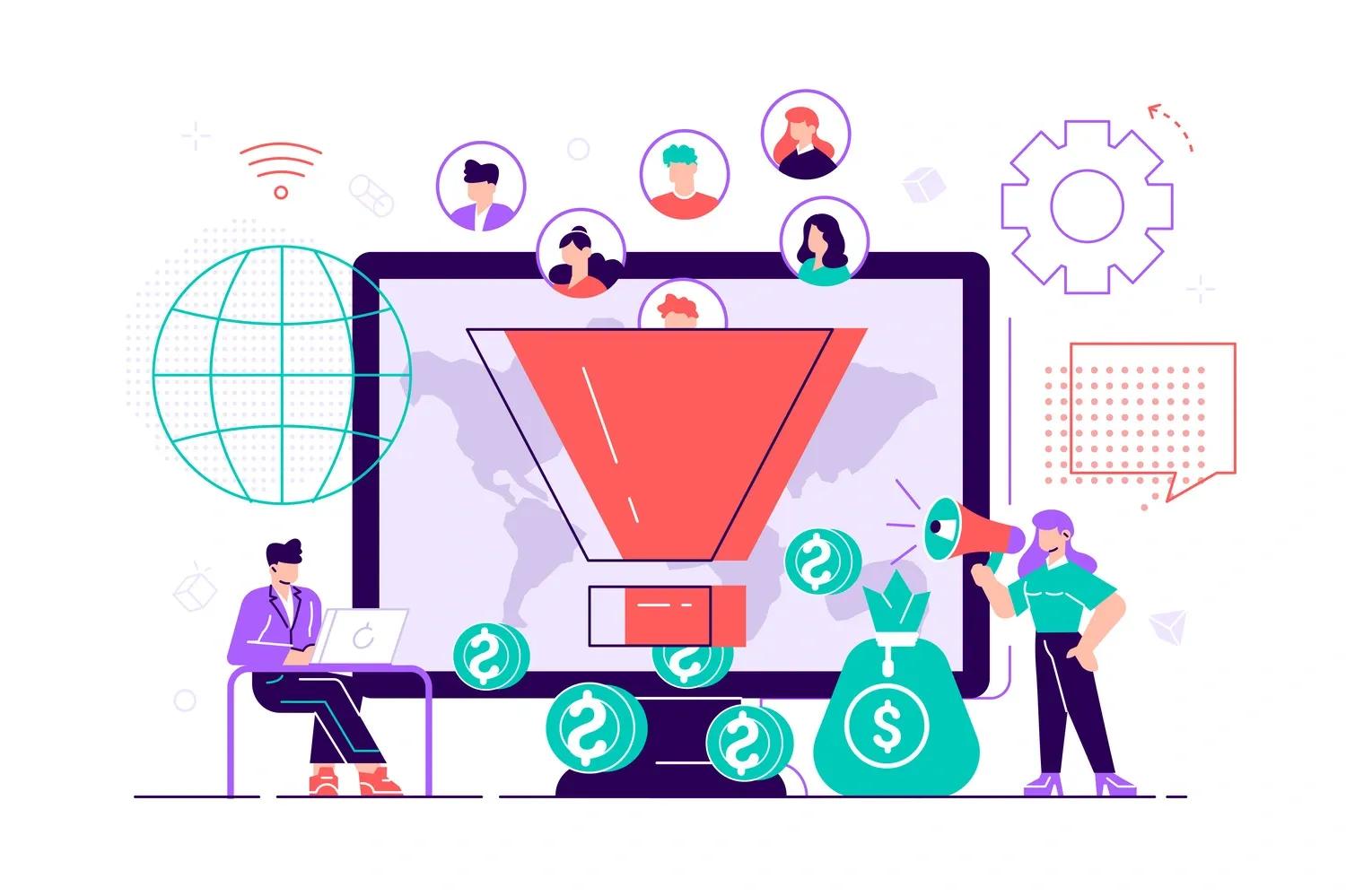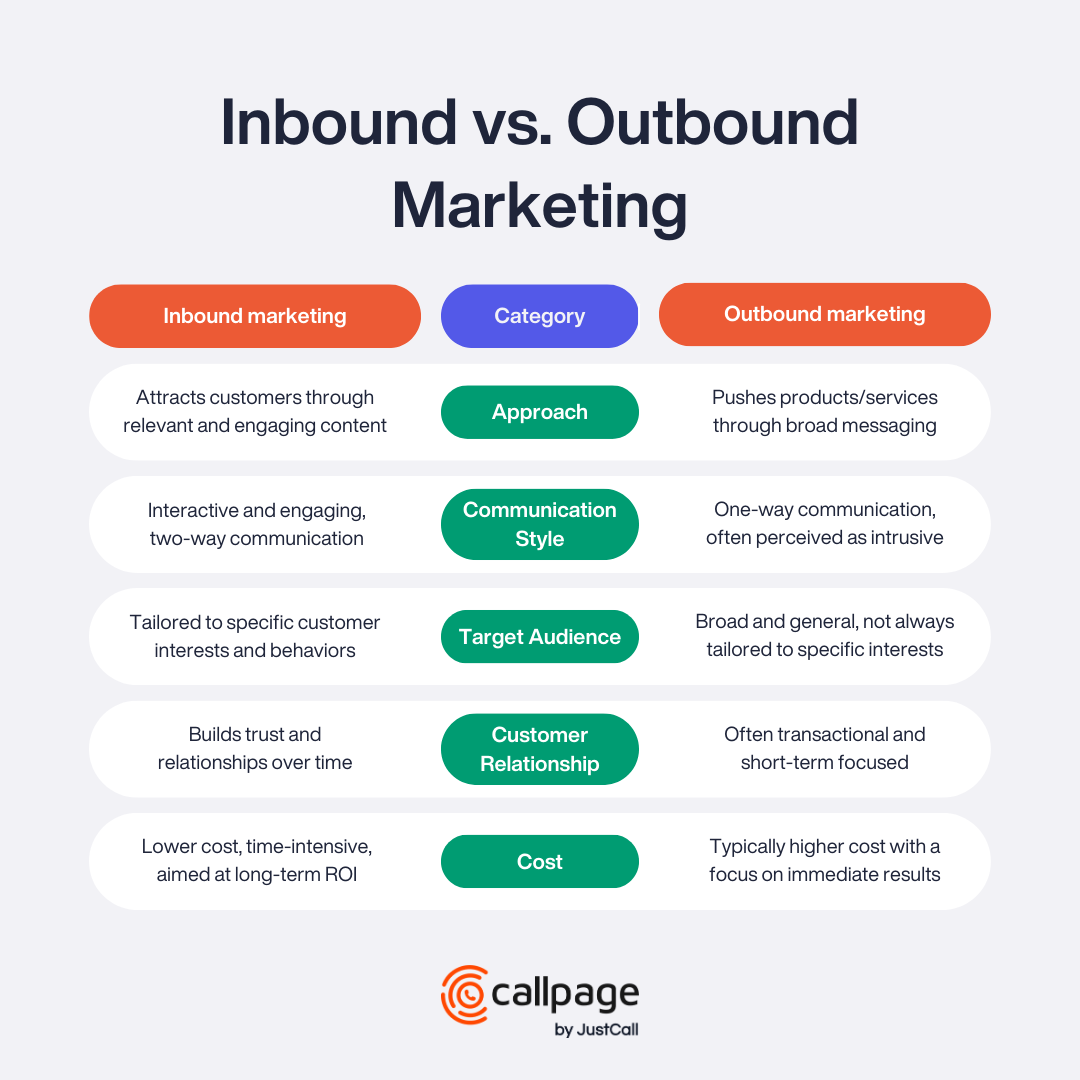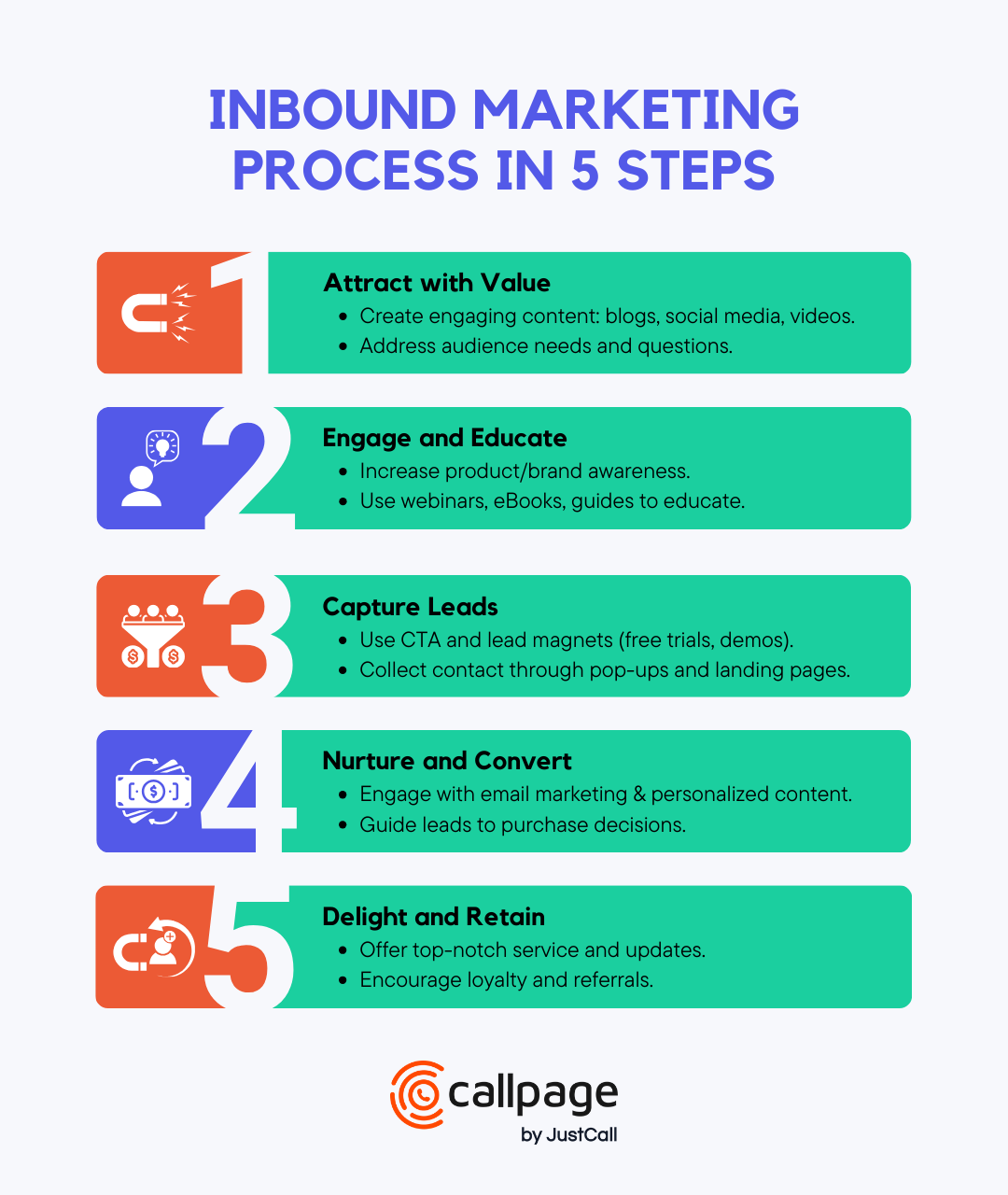
What Is Inbound Marketing? Understanding the Process
Curious about what inbound marketing is and how it works? Dive into our comprehensive guide where you'll discover the art of attracting customers naturally with valuable content, differentiating it from traditional outbound methods.
Welcome to a live demonstration of inbound marketing — this very article! Our goal here is to offer valuable insights to curious minds like yours who are eager to learn about inbound marketing.
This process is a win-win: while we attract organic traffic to our site, you gain valuable information. And if our content aligns with your needs, it might just pique your interest in our services. What's crucial here is that our offerings are designed to address the very challenges discussed in this article.
In essence, this is content marketing at its core, a key tactic within the inbound marketing arsenal. But why label it "inbound"? Because it's all about creating organic, incoming traffic through a free value proposition. And "incoming" is just another word for "inbound".
You chose to click on this article because you decided it might be useful; we didn't intrude on your online space with a flashy ad or a sponsored post in your social media feed.
Let's start with the basic ideas of inbound marketing and then move step-by-step to the more complex stuff.
What Is Inbound Marketing? Definition
Inbound marketing is a digital marketing approach that draws in customers naturally by offering them free, valuable content, like helpful articles or guides.
The term "inbound" is quite illustrative in this context. It implies the traffic you generate is "incoming," signifying that customers come to you. This is in contrast to outbound marketing, where the approach is more about actively reaching out to the customers.
In simpler terms, think of inbound marketing as a magnet. Instead of reaching out to your audience with direct sales pitches (which can sometimes be intrusive or unwelcome), you draw them in with content that they find useful or interesting. This could be anything from informative blog posts, how-to guides, and educational videos to free webinars and eBooks.
The idea is to create touchpoints that resonate with potential customers at various stages of their buying journey. By offering valuable information, you're not only solving their immediate problems but also positioning your brand as an authority in your field. This naturally fosters trust and credibility, which are crucial for building long-lasting customer relationships.
Inbound marketing is more subtle and customer-centric compared to outbound marketing. It respects the consumer's need for information and time, allowing them to engage with your brand at their own pace. By providing them with the right content at the right time, you're effectively guiding them through the decision-making process, leading to more meaningful and lasting connections.
Inbound Marketing vs. Outbound Marketing

Sometimes referred to as "traditional marketing," outbound marketing involves reaching out to potential customers through methods like television and internet ads, billboards, cold calling, and direct mail. It's characterized by attempts to interrupt and capture the attention of people who may or may not be interested in the product or service.
In contrast, inbound marketing is more subtle and customer-centric compared to outbound marketing. It respects the consumer's need for information and time, allowing them to engage with your brand at their own pace.
An inbound marketing strategy focuses on creating and sharing valuable content that attracts people to your brand. This content is designed to be found by those who are actively searching for information related to your industry, product, or service. It's about pulling customers in rather than pushing a message out.
READ ALSO: Inbound vs Outbound Sales: Key Differences and Strategies
Inbound Marketing vs. Inbound Lead Generation
The main difference between inbound marketing and inbound lead generation is that marketing is a broader term that encompasses lead generation, as well as other activities that aim to build trust, loyalty, and advocacy among your customers. This includes creating brand and product awareness, as well as demand generation.
Lead generation is a more focused and measurable process that deals with capturing the contact information of potential customers who have shown interest in your content or offer. Its aim is to generate qualified leads for your sales team through landing pages, forms, pop-ups, chatbots, quizzes, surveys, and more.
READ ALSO: Demand Generation vs. Lead Generation: Differences Explained
How Does Inbound Marketing Work?

For this article, we divided inbound marketing into five steps:
- Attracting with value: Draw potential customers in with valuable content.
- Engaging and educating: Provide informative content to engage and educate them.
- Capturing leads: Use strategies to gather leads, like sign-ups or downloads.
- Nurturing and converting: Foster these leads into customers through targeted communication.
- Delighting and retaining: Keep customers happy and engaged for repeat business and referrals.
Inbound lead generation essentially focuses on the two main steps of inbound marketing: attracting potential customers with valuable content and then capturing their details to turn them into leads.
READ ALSO: A Sales Manager’s Guide to Inbound Call Center Sales Techniques and Software
1. Attract with value
The goal of inbound marketing strategies is to attract people by giving them something valuable. This could be interesting blog posts, useful social media posts, or how-to videos. At this point, you’re not trying to sell anything, just getting people interested in what you have to say.
After creating good content, it’s important to make sure people can find it. This is where SEO (Search Engine Optimization) comes in. SEO means making your blog posts and website easy to find on search engines. And it’s not just for websites; it’s also important for videos on platforms like YouTube. This way, more people can find and enjoy your content.
So, how do you make your blog content SEO-friendly? First, ensure your website is technically sound and easy for search engines to navigate. This means having a clear page title and meta description. Also, your content should be useful and informative. Another key factor is your website's authority, which improves when highly-rated websites link to yours. This helps boost your site's ranking in search results.
READ ALSO: Inbound vs. Outbound Leads — Key Differences and How to Leverage Both
2. Engage and educate
Let's say someone from your target group finds your article on Google and clicks on it. What's next? After grabbing the attention of a future customer (hopefully), it's time to really connect with them. This is your chance to start a good relationship.
Give them more detailed content that teaches and provides useful information. Include links to other things they might like to read about.
This is how you make your brand more known and show that you're an expert in your area. Doing this builds trust and gets people ready to buy from you in the future. It's also a time to introduce your product or service to a lot of people and get them interested.
If your article is about something related to what you're selling (and it's a good idea to do that), explain how your product can help them.
But remember, it's not just about selling. Think of this as giving them a helpful guide or a solution to their problems. If your content is really good and full of useful info, you're showing that your brand is trustworthy and knows what it's talking about. When people trust you, they're more likely to believe your recommendations.
But be careful. If you recommend something that doesn't match what you say or if you're not genuine, you can quickly lose that trust. Always be honest and sincere to keep your audience interested and loyal.
READ ALSO: How Quickly Should You Contact Inbound Leads?
3. Capture leads
Now that you've got the interest and trust of your target audience, it's time to move to the next step: capturing leads. This is about turning interested visitors into potential customers.
A great way to do this is by using lead capture forms on your website. These forms can be simple, like asking for an email address to subscribe to a newsletter. Or, they can offer something more, like a free ebook or a webinar sign-up in exchange for more detailed information.
Make sure your forms are easy to find and use. You don’t want to frustrate your visitors with complicated forms or hard-to-find sign-up pages. Keep it simple and straightforward.
Another effective tool is a simple call-to-action (CTA). This is a button or link that encourages your visitors to take a specific action, like "Download our free guide" or "Sign up for a free trial." Place these CTAs strategically throughout your content where they make the most sense.
Also, consider using pop-up widgets, like the CallPage one, for instant callbacks or scheduling meetings. These are particularly effective because they engage visitors at the peak of their interest and offer immediate interaction with your brand.
Remember, the goal of capturing leads is not just to gather contact information. It's about starting a conversation and building a relationship. By providing value and making it easy for visitors to engage further, you're setting the stage for future interactions that could lead to sales. Which brings us to the next step.
READ ALSO: How to Qualify Inbound Leads?
4. Nurture and convert
Seeing your inbound strategy generate leads is great. But leads aren't your end goal. You want paying customers. This is where your sales and marketing teams should turn to lead nurturing. This means taking these leads and guiding them towards making a purchase.
First, start with email marketing. Send your leads regular, relevant content that aligns with their interests and needs. This could include product updates, industry news, or special offers. The key is to keep your brand at the top of their mind without overwhelming them with too many emails.
Personalization is crucial in this stage. Use the information you've gathered about your leads to tailor your messages. For example, if someone downloaded a guide about social media marketing, send them more content on that topic. This shows that you understand and care about their specific interests.
Also, use lead scoring to identify which leads are most likely to convert. This means assigning points based on their interactions with your content, website, or emails. A high score indicates a lead is more engaged and likely closer to a purchase.
Engage with your leads through other channels too. Social media can be a powerful tool for nurturing relationships. Respond to comments, share relevant content, and even reach out directly to leads who are actively engaging with your brand online.
Webinars and live events are another great way to connect with leads. These events provide an opportunity to demonstrate your expertise, showcase your products, and directly answer questions from potential customers.
During this nurturing phase, it's important to track and analyze your results. Use analytics to understand what's working and what isn't. This will help you refine your strategy and focus on the most effective tactics.
Finally, when a lead shows signs of being ready to buy, make the purchasing process as easy and seamless as possible. This could mean providing a clear and straightforward checkout process on your website, offering assistance through customer service, or even reaching out directly to guide them through the sale.
5. Delight and retain
After converting leads into paying customers, delighting and retaining them is the next crucial step. This stage is about creating a positive, lasting relationship with your customers, turning them into loyal fans and advocates for your brand.
Start by delivering an exceptional customer experience. This means ensuring your product or service meets, if not exceeds, their expectations. Pay attention to customer feedback and be proactive in resolving any issues. A happy customer is more likely to return and recommend your brand to others.
READ ALSO: How to Create an Inbound Marketing Funnel? Examples for Different Industries
Make sure your marketing and sales teams continue engaging with your customers even after the sale. Send them personalized follow-up emails thanking them for their purchase and asking for feedback. This shows that you value their opinion and are committed to continuous improvement.
Offer exclusive content, discounts, or early access to new products to your existing customers. These perks make your customers feel special and appreciated, encouraging loyalty.
Encourage your customers to join a community around your brand. This could be a social media group, a forum on your website, or an in-person meetup. A sense of community fosters brand loyalty and provides valuable insights into your customers' needs and preferences.
Don't forget about content marketing at this stage. Continue providing valuable content that helps your customers get the most out of their purchases. This could be how-to guides, tips and tricks, or customer success stories.
Finally, implement a referral program. Encourage your satisfied customers to refer friends or colleagues to your brand. Offer incentives for both the referrer and the referee, creating a win-win situation.
By focusing on delighting and retaining your customers, you not only ensure a steady stream of repeat business but also turn your customers into brand ambassadors who will help attract new leads. This completes the inbound marketing cycle, creating a sustainable growth engine for your business.
Inbound Marketing Automation
Inbound marketing automation is about using software to automate inbound marketing efforts, making the process more efficient and effective. By automating repetitive tasks, businesses can focus more on creating personalized experiences for their audience.
CallPage serves as an exemplary case of how inbound marketing automation can significantly impact lead generation and customer engagement. Through automated widgets that offer instant callbacks or schedule meetings, CallPage simplifies the process of converting website visitors into leads. This automation ensures that potential customers receive immediate attention, boosting the chances of conversion without requiring constant manual intervention.
Creating an Inbound Marketing Strategy That Works
To wrap up, developing an inbound marketing strategy that truly works requires a holistic approach. Begin by understanding your audience and crafting content that directly addresses their needs and interests. As you attract, engage, and educate your audience, make sure to optimize your content for search engines to increase its visibility. Utilizing lead capture software effectively is crucial in converting your interested audience into potential leads.
Nurture these leads with personalized content and interactions, gradually guiding them toward making a purchase. Remember, the key to successful inbound marketing is not just acquiring new customers but also retaining them. Delight your customers with exceptional service and continuous engagement, turning them into loyal advocates for your brand.
Inbound marketing is a dynamic and ongoing process. It requires constant monitoring, analysis, and adaptation to the changing needs and behaviors of your audience. By focusing on providing value at every stage of the customer journey, you create a sustainable marketing strategy that not only drives growth but also fosters a loyal customer base.
Start generating leads today!
Start a 14-day free trial now,
set up the widget on your site, and see how many more leads you can capture with CallPage
- No credit card required
- 10 minutes set up
- 14 days fully-features free trial